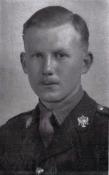
|
The King's School Canterbury |
Roll of Honour |
| Lieutenant Gerard Bruce ARMSTRONG (293742) | |
|
B Squadron, 1st King's Dragoon Guards Date of birth: 19th February 1923 Date of death: 24th January 1944 Killed in action aged 20 Buried at Cassino War Cemetery Plot VII Row E Grave 22 |

|
| He was born at Carlisle on the 19th of February 1923, the second son of William Herbert Fletcher Armstrong CIE, MA FCS, Indian Educational Service, and Dorothy Lottie (nee Hornell) of Lahore in the Punjab and of 19 Warwick Square, Carlisle. He was educated at The Hill School, Westerham, Kent, at The Hall, Hampstead, and at the King's School Canterbury from September 1936 to July 1941, where he was a Senior Scholar in 1940, was appointed as a School Monitor in September 1940 and as Head of Walpole House in September 1940. He also played in the Rugby XV 1940/41, was Captain of Shooting, was Hon Secretary of the Harvey Society and was editor of The Cantuarian. He was appointed as First monitor in the summer of 1941 and was a Sergeant in the Officer Training Corps. He matriculated for St John's College Cambridge in 1941, where his tutor was C.W. Guillebaud, but he did not complete his degree. Instead, he accepted a commission as a 2nd Lieutenant in the King's Dragoons, Royal Armoured Corps on the 19th of September 1943. He visited King's in November 1943, shortly before being posted overseas. The 1st King's Dragoon Guards, an armoured car regiment, landed in Italy at Salerno on the 24th of September 1943. From the 10th of November 1943 they began to act as infantry in the area of the Garigliano River. It was miserably wet and the area was carpeted with mines with the enemy patrolling aggressively at night when the Dragoons took to their slit trenches. On the night of the 17th of January 1944 B Squadron was put into the line to fill a gap of some six kilometres, to the southeast of Monte Camino, for a planned attack on the 28th. On the 24th of January Gerald Armstrong and his Squadron Leader, Captain R.W. Howes who was on attachment from the South African Tank Corps, were conducting a reconnaissance of the area on foot when they walked into the tripwire of a booby trapped Teller mine which exploded killing Howes outright and leaving Gerald Armstrong so badly wounded that he died in a few minutes. His Housemaster wrote:- "I can see Gerry now on the first day he arrived in School, a very white faced unpromising looking little boy, with his mother. Many times later we laughed about that first meeting. The School suited him and he was always happy there. A boy with many interests, particularly keen on nature study, he later became a very good biologist. Though he looked slight in build, he was full of energy, whether as a wing forward for the School or as a half miler. But it was his character and influence which will never be forgotten in Walpole. Early in the war he became Head of House. He was its first "young" Head boy, at an age for command which, before the war, would have been thought ridiculous. But command he did, and the house flourished under him. His wisdom and common sense came to be known almost as well as his cheerful laugh. All counted themselves lucky to serve under Gerry Armstrong and he was universally beloved." He is commemorated on the war memorial at St John's College Cambridge. |
|
| Walpole House |
Back